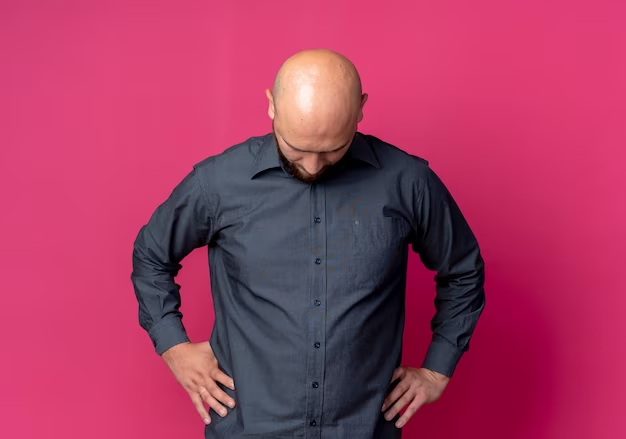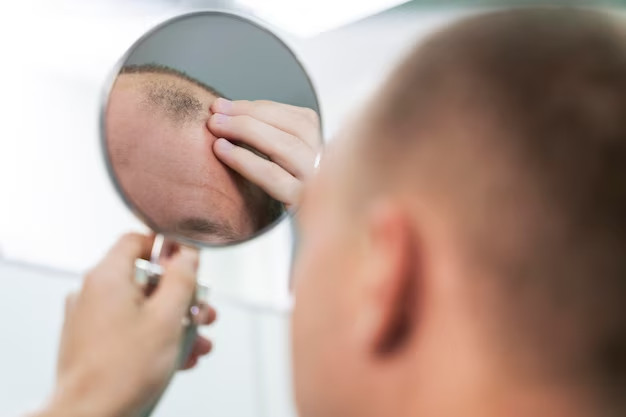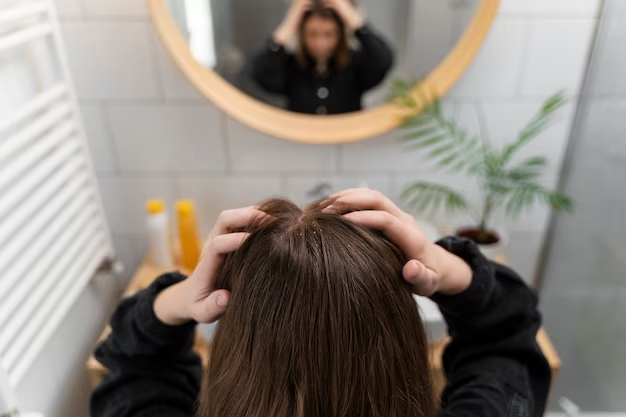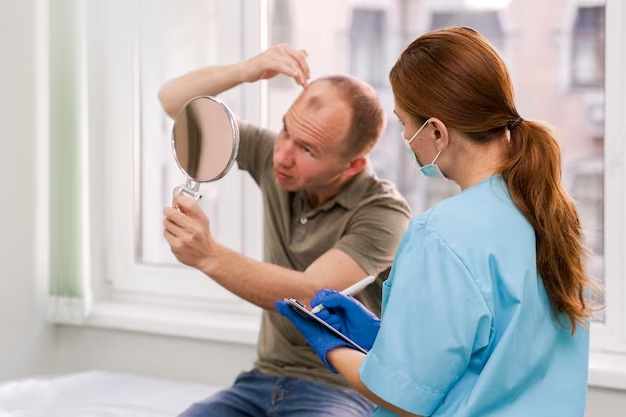
Menu

Male Pattern Baldness (MPB) is a prevalent condition affecting men worldwide, characterized by a distinctive pattern of hair loss. Understanding the significance and emotional impact of Male Pattern Baldness is crucial for those navigating this common yet often challenging journey. With advancements in medical science and various treatment options available, individuals experiencing MPB can explore personalized solutions that cater to both their physical and emotional well-being.
Table of Contents
ToggleMale Pattern Baldness, also known as androgenetic alopecia, is a hereditary condition that causes hair loss in a specific pattern, typically starting at the temples and crown. It is the most common cause of hair loss in men, with a recognizable pattern that progresses over time.
Male Pattern Baldness is linked to genetic factors and the influence of androgens, particularly dihydrotestosterone (DHT). Understanding this condition involves recognizing the impact of hormonal shifts on hair follicles, leading to their miniaturization. While MPB is a natural and common occurrence, numerous treatments and interventions are available to address its progression and help individuals regain confidence in their appearance.
The impact of Male Pattern Baldness extends beyond the physical aspect, influencing self-esteem and confidence. As hair is often linked to identity and attractiveness, experiencing Male Pattern Baldness can lead to emotional challenges. Understanding this impact is essential for individuals and those around them to provide empathetic support.
Recognizing the significance of Male Pattern Baldness as more than a cosmetic concern fosters a compassionate approach to its management. Open conversations, awareness, and accessible solutions contribute to creating a supportive environment where individuals can navigate this aspect of their journey with resilience and confidence.
Male Pattern Baldness (MPB) is a distinctive and often hereditary form of hair loss that affects a significant portion of the male population. Delving into its definition, characteristics, and genetic underpinnings provides a comprehensive understanding of this prevalent condition.
Male Pattern Baldness is a specific type of hair loss characterized by a predictable pattern of receding hairlines and thinning at the crown. Typically, it begins with a receding hairline at the temples, forming an “M” shape, and progresses to partial or complete baldness at the crown. The gradual nature of this process sets Male Pattern Baldness apart from other forms of hair loss.
This distinctive pattern is often associated with genetic factors and hormonal influences, specifically the impact of dihydrotestosterone (DHT) on hair follicles. Recognizing these defining characteristics is crucial for accurate diagnosis and the development of personalized strategies to manage and address Male Pattern Baldness effectively.
Genetic factors play a pivotal role in Male Pattern Baldness, making it a hereditary condition. The inheritance of specific genes from both parents contributes to an increased susceptibility to MPB. The primary culprit is dihydrotestosterone (DHT), a derivative of testosterone, which binds to hair follicles and triggers the thinning and eventual loss of hair.
Understanding the hereditary links of Male Pattern Baldness is essential, as individuals with a family history of MPB may have a higher likelihood of experiencing it themselves. Genetic counseling and early intervention strategies can assist in addressing and managing the impact of hereditary factors on the progression of Male Pattern Baldness.
Male Pattern Baldness (MPB) is influenced by a combination of hormonal, genetic, and environmental factors. Understanding the intricate causes provides valuable insights into why this condition occurs and how it progresses.

One of the primary causes of Male Pattern Baldness is the influence of hormones, particularly dihydrotestosterone (DHT). This hormone, derived from testosterone, binds to hair follicles, leading to their shrinkage and eventual cessation of hair growth. The sensitivity of hair follicles to DHT is a key factor in the development of MPB.
Genetics plays a significant role in determining an individual’s susceptibility to Male Pattern Baldness. If there is a family history of MPB, the likelihood of experiencing it increases. Specific genetic markers inherited from both parents contribute to the predisposition, highlighting the hereditary nature of this condition.
While hormones and genetics are primary contributors, age and lifestyle factors also play a role in the onset and progression of Male Pattern Baldness. As individuals age, the likelihood of experiencing MPB increases. Additionally, factors such as poor nutrition, smoking, and high-stress levels can exacerbate hair loss in genetically predisposed individuals.
Recognizing Male Pattern Baldness (MPB) in its early stages empowers individuals to take proactive steps toward management and treatment. Understanding the signs and utilizing tools like the Norwood scale aids in identifying and addressing MPB effectively.
Early detection of Male Pattern Baldness involves paying attention to subtle changes in hair density and the overall appearance of the hairline. Key signs include a receding hairline at the temples, thinning at the crown, and the formation of the characteristic “M” shape. Increased hair shedding during daily activities like showering or combing may also indicate the onset of MPB.
The Norwood scale is a valuable tool for gauging the progression of Male Pattern Baldness. This scale categorizes MPB into various stages, from minimal to advanced, helping individuals and healthcare professionals assess the extent of hair loss. Understanding the Norwood scale allows for accurate communication about the severity of MPB and aids in determining suitable treatment options.
Male Pattern Baldness (MPB) is a common concern, but several effective treatments can address its progression and restore hair growth. Exploring pharmacological interventions and surgical options provides individuals with diverse avenues for managing MPB.
Pharmacological treatments for Male Pattern Baldness aim to address hormonal factors and stimulate hair growth. Two prominent medications have demonstrated efficacy in managing MPB:
Finasteride is an oral medication that inhibits the conversion of testosterone to dihydrotestosterone (DHT), the hormone responsible for shrinking hair follicles in MPB. By reducing DHT levels, Finasteride helps maintain the size of existing follicles and promotes hair regrowth. It is a long-term treatment requiring consistency for sustained results.
Minoxidil is a topical solution applied directly to the scalp. It stimulates blood flow to the hair follicles, prolonging the growth phase of hair and promoting thicker strands. Minoxidil is available over the counter and is suitable for both men and women. Regular application is essential for optimal results.
For individuals seeking more immediate and permanent solutions, surgical interventions provide viable options to address Male Pattern Baldness:
Hair transplantation involves harvesting hair follicles from areas of the scalp with healthy growth (donor sites) and transplanting them to areas with thinning or no hair (recipient sites). This procedure allows for the redistribution of hair, providing a natural and lasting solution to MPB. Techniques like Follicular Unit Transplantation (FUT) and Follicular Unit Extraction (FUE) are commonly employed.
Scalp reduction is a surgical procedure that involves removing sections of the scalp with no hair growth and stretching the adjacent areas with hair to cover the removed portions. While less common today due to the prevalence of hair transplant procedures, scalp reduction can still be a suitable option for certain cases.
Taking proactive steps through preventive measures and lifestyle changes is crucial for managing and potentially slowing down Male Pattern Baldness (MPB). Incorporating specific nutritional considerations, adopting effective haircare practices, and making lifestyle adjustments contribute to a holistic approach to hair health.

Male Pattern Baldness (MPB) may be inevitable for some, but adopting preventive measures and lifestyle changes can significantly impact its progression. By focusing on nutritional considerations, implementing haircare practices to minimize hair loss, and making essential lifestyle adjustments, individuals can proactively manage their hair health.
Male Pattern Baldness (MPB) extends beyond the physical realm, often taking a toll on individuals emotionally. Understanding the emotional effects and exploring effective coping mechanisms and support options are vital components of managing the psychological impact of MPB.
When dealing with Male Pattern Baldness (MPB), seeking professional advice is a crucial step in understanding the condition, exploring effective treatments, and receiving personalized guidance. Consulting with a dermatologist or trichologist ensures informed decisions and tailored approaches to manage MPB.

The landscape of Male Pattern Baldness (MPB) research is dynamic, with ongoing studies and potential breakthroughs offering hope for innovative treatments. Exploring current research endeavors and the exciting possibilities on the horizon provides a glimpse into the future of managing MPB.
In conclusion, the journey of addressing Male Pattern Baldness (MPB) is multi-faceted, encompassing not only the physical aspects of hair loss but also the emotional and psychological dimensions. From understanding the causes and identifying early signs to exploring diverse treatment options and embracing preventive measures, individuals have a range of tools to manage MPB effectively. The significance of seeking professional advice, both from dermatologists and trichologists and staying abreast of ongoing research underscores the commitment to comprehensive care. As research advances and potential breakthroughs emerge, the future of MPB management holds exciting possibilities, offering hope for more tailored and innovative treatments. Ultimately, a holistic approach that integrates lifestyle adjustments, psychological support, and personalized interventions empowers individuals to navigate the complexities of Male Pattern Baldness with resilience and confidence.
While Male Pattern Baldness is largely hereditary, adopting a healthy lifestyle, managing stress, and seeking early professional advice can help slow down its progression and potentially minimize its impact.
Some over-the-counter products like minoxidil may help stimulate hair growth in certain individuals, but their effectiveness varies. Consulting with a healthcare professional for personalized advice is crucial for determining the most suitable approach.
Hair transplantation can provide a lasting solution by redistributing healthy hair follicles, but it doesn’t prevent further hair loss. It’s essential to consider it as part of a comprehensive approach and follow professional guidance for optimal results.

